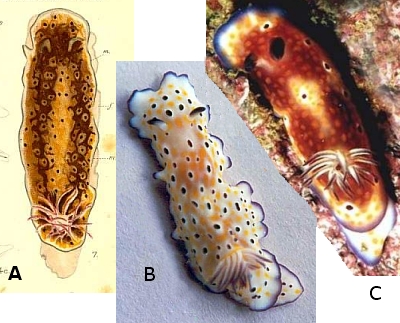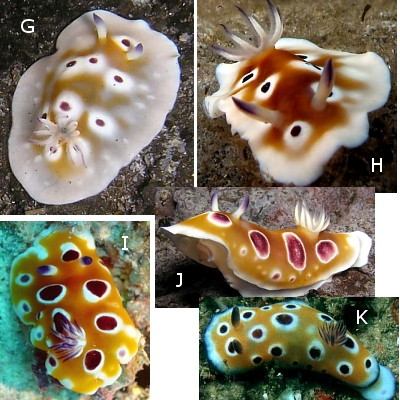Variation in Chromodoris cavae
May 4, 2007
From: Bill Rudman


I have prepared a summary on C. tennentana [message #19875] to accompany recent messages concerning Chromodoris tennentana . There have also been many other messages showing one, or a number of other purple-spotted species, from the Indian Ocean. I present here a summary showing why I think all this variation is colour variation in a single species,Chromodoris cavae.
Chromodoris cavae was first described from Zanzibar (Eliot, 1904) and the description included a good colour description and painting of the living animal which can be seen on the Fact Sheet. I have repeated the colour description below and accumulated photos from the various messages on the Forum to show how the various colour variants merge into one another.
Chromodoris cavae
"Several specimens from the East and West Coasts of Zanzibar. The following are the notes on the living animal:- Colour yellowish white, with indefinite large drab blotches laterally. Edges of mantle and foot bordered with light violet. On the back are black spots surrounded by a white line and also irregular dull orange spots. The foot is not very broad, white in colour, with a row of dull orange spots and black spots below them. The tip and anterior side of the rhinophores are purple; the lamellae are reduced to fine striations"..... Eliot, 1904
Like C. tennentana, this species has dark purple spots ringed with white, and a washy purple border to the foot and the mantle. It may have yellowish spots, but they are larger and more diffuse than in C. tennentana, and are intermingled with the purple spots rather than restricted to the outer mantle. One consistent difference in C. cavae, is that the gills and rhinophores are white with washy purple tips. In some colour extremes the purple becomes more dominant, with the rhinophore clubs becoming dark purple and the gills becoming lined with purple, but that is most unusual, and quite different from the colours of C. tennentana.
Specimens from Reunion Island show an incredible range of variation, including forms in which the diffuse yellow-orange spots become browner and expand to form one large brownish patch. In the most extreme form of this pattern, the purple spots become fewer and much larger and all the mantle, except for a narrow white band at the edge, becomes a uniform yellow-brown background. I had earlier separated specimens from South Africa with that colour pattern into a separate 'species' which I called Chromodoris cf. geminus, but the photos we now have from Reunion Is, Mauritius and South Africa suggest that this is just an extreme colour variant of C. cavae.
I could of course be quite wrong, but for those who believe in parsimony, this seems to be a much more parsimonious hypothesis than 5 or 6 new species.
-
Eliot, C.N.E. (1904) On some nudibranchs from East Africa and Zanzibar. Part IV. Proceedings of the Zoological Society of London, (1904): 380-406.
Bill Rudman
Rudman, W.B., 2007 (May 4) Variation in Chromodoris cavae. [Message in] Sea Slug Forum. Australian Museum, Sydney. Available from http://www.seaslugforum.net/find/19876
PHOTOS: A, original painting of C. cavae.
B, message #8894 India.
C, #1486 S. Africa.
D, #19851 Reunion Is.
E, #19870 Reunion Is.
F, #19869 Reunion Is.
G, #19868 Reunion Is.
H, #19862 Reunion Is.
I, #8271 Mauritius.
J, #19868 Reunion Is.
K, #1516 Sth Africa.
Related messages
-
Re: Chromodoris cavae feeding
From: Colin Ogden, August 28, 2008 -
Re: Chromodoris cavae from South Africa
From: Colin Ogden, May 7, 2007 -
Re: Chromodoris cavae from Reunion Island?
From: Philibert Bidgrain, May 4, 2007 -
Re: Chromodoris cavae from Reunion Island?
From: Philibert Bidgrain, May 4, 2007 -
Re: Chromodoris cavae from Reunion Island?
From: Hugues Flodrops, May 4, 2007 -
About Chromodoris cf geminus from Reunion Island
From: Philibert Bidgrain, May 4, 2007 -
Chromodoris cavae from Reunion Island?
From: Hugues Flodrops, May 3, 2007 -
Chromodoris cavae from India
From: K. Padmakumar, January 29, 2003 -
Rediscovery of Chromodoris cavae Eliot, 1904
From: Bill Rudman., November 13, 1999 -
Chromodoris vicina? from Sth Africa
From: Valda Fraser, November 9, 1999
